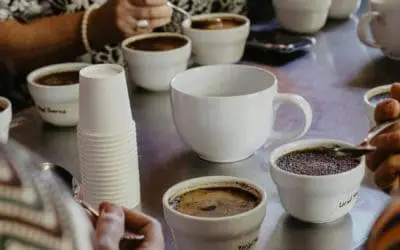If you start your day with coffee, you’re not alone. From creamy lattes to strong black brews, coffee is the go-to drink for millions. But have you ever wondered what’s really inside your cup—and how it got there?
Understanding what coffee is, where it comes from, and how it became a global obsession can help you, as an aspiring coffee aficionado, take your appreciation to the next level.
Coffee Chemistry: More Than Just Caffeine
The buzz you get from coffee mostly comes from caffeine, a natural stimulant that helps you stay alert. But that’s just the beginning. Coffee is filled with over 1,000 chemical compounds, each playing a role in how it smells, tastes, and makes you feel.
Some key players:
- Chlorogenic acids: These give coffee its signature bitterness and have antioxidant properties.
- The Maillard reaction: This is the same process that gives toasted bread and grilled meat their rich flavour. It happens during roasting and creates those deep, complex aromas you love—like caramel, nuts, and even chocolate.
So, next time you catch a whiff of your favourite roast? That’s science in action.
The Bean’s Journey: From Farm to Mug
Coffee doesn’t just appear in your cup—it travels a long way. Here’s how:
- Grown with care – Most coffee comes from two species: Arabica (smoother, more flavourful) and Robusta (stronger, more bitter). They’re grown in tropical regions with just the right mix of sun, rain, and altitude.
- Picked at peak ripeness – Harvesting is done by hand in many regions to ensure only the ripest cherries are used.
- Processed for flavour – The beans are removed from the cherry using wet or dry methods, which affect how the coffee tastes.
- Roasted to perfection – Light roast? You’ll taste the bean’s origin more. Dark roast? Expect bold, smoky flavours.
- Shipped worldwide – Finally, the roasted beans are packed, shipped, and brewed—ending up in your kitchen, your café, or your favourite mug.
Coffee’s Global Story
Coffee’s tale began in Ethiopia, with the legendary goatherd Kaldi, who noticed his goats acting wild after eating coffee cherries. Curious, he tried them himself—and felt awake and energized. We know the feeling, right?
From there, coffee spread through Yemen, the Middle East, and then to Europe in the 1600s. Coffeehouses popped up in cities like Oxford and Paris, quickly becoming hotspots for thinkers, artists, and revolutionaries.
In the 1700s, European colonizers introduced coffee to the Caribbean, Central and South America and Southeast Asia, turning it into one of the world’s most important crops. Countries like Brazil and Colombia became coffee powerhouses—and remain that way today.
Culture in a Cup
Coffee is more than just a drink—it’s a ritual:
- In Italy, espresso is a fast-but-fancy daily routine.
- In Turkey, coffee is a symbol of hospitality, often brewed in a pot called a dallah and served with sweets.
- In Sweden, they have fika—a cozy coffee break shared with friends or coworkers.
- In North America, coffee culture spans from drive-thru chains to slow, artisanal pour-overs.
Wherever you go, coffee brings people together. It sparks conversation, fuels ideas, and marks both big moments and small breaks.
Challenges Behind the Brew
Coffee also has a darker side:
- Climate change threatens coffee farms with shifting temperatures and new pests.
- Unfair wages remain a problem for many small-scale farmers.
- Sustainable choices like Fair Trade and Rainforest Alliance certification help—but there’s still work to do.
As a coffee lover, you can support better practices by buying ethically sourced beans and learning about where your coffee comes from.
Sip With Purpose
Understanding the chemistry, journey, and culture of coffee lets you enjoy more than just the flavour—you start to experience the story behind every cup.
So the next time you take a sip, think about:
- The farmer who picked the cherry.
- The roaster who found the perfect flavour profile.
- The centuries of culture behind your favourite blend.
This isn’t just a drink—it’s a global connection, a shared language, and a story you get to be part of.
If you are enjoying what you are reading here, there is more where it came from. Be sure to support us by sharing, friending, liking and subscribing to The Coffee Authority Weekly and build the community of coffee lovers.



0 Comments